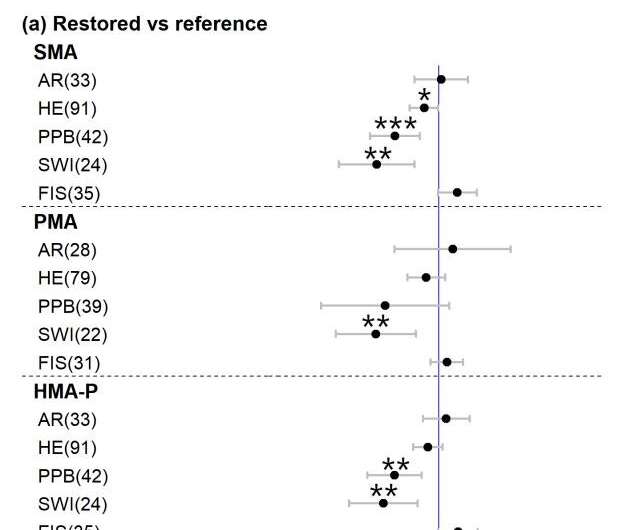This article has been reviewed according to Science X's editorial process and policies. Editors have highlighted the following attributes while ensuring the content's credibility:
fact-checked
peer-reviewed publication
trusted source
proofread
Global ecological restoration does not enhance genetic diversity in restored plant populations, study finds

Almost ubiquitous human disturbance has caused serious negative genetic consequences for wild plants worldwide, such as a decrease in intraspecific genetic diversity, which is likely to threaten individual survival and population persistence. Ecological restoration has been widely practiced in various types of ecosystems. However, it is still unclear whether and to what extent ecological restoration has restored the genetic diversity of plant populations.
To fill this knowledge gap, Dr. Wei Xinzeng and his colleagues from the Wuhan Botanical Garden of the Chinese Academy of Sciences compiled a global dataset to compare the genetic diversity between restored and reference or degraded populations, and explored the underlying drivers, such as species characteristics and restoration strategies.
Genetic diversity in restored populations was significantly lower than in reference populations, and was comparable to that in degraded populations. The inbreeding coefficient was consistently comparable between restored populations and reference or degraded populations.
Ecological restoration effectively enhanced genetic diversity of herb species but not woody species, and grassland but not forest ecosystems. Passive restoration rather than active restoration, seeding rather than planting, and populations restored with mixtures from different donor populations rather than only a single source population all significantly enhanced the genetic diversity of restored populations.
The genetic diversity of restored populations was comparable to the reference population when the restoration time was ≥50 years, but was significantly lower than the reference populations when the restoration time was <50 years.
The researchers made the following recommendations for improving genetic diversity in restored populations. Genetic diversity recovery should not be treated not only as a co-benefit of ecological restoration, along with other aims, but as a key goal in future ecological restoration with plant species.
In addition, appropriate strategies should be adopted to improve and maintain genetic diversity in restored populations and to reduce genetic risk and resource use.
Moreover, genomic approaches, such as population genomics, should be used to improve seed sourcing, assessment, and monitoring of restoration efforts.
The paper is published in the Journal of Applied Ecology.
More information: Xinzeng Wei et al, Impacts of ecological restoration on the genetic diversity of plant species: A global meta‐analysis, Journal of Applied Ecology (2023). DOI: 10.1111/1365-2664.14390
Journal information: Journal of Applied Ecology
Provided by Chinese Academy of Sciences




















